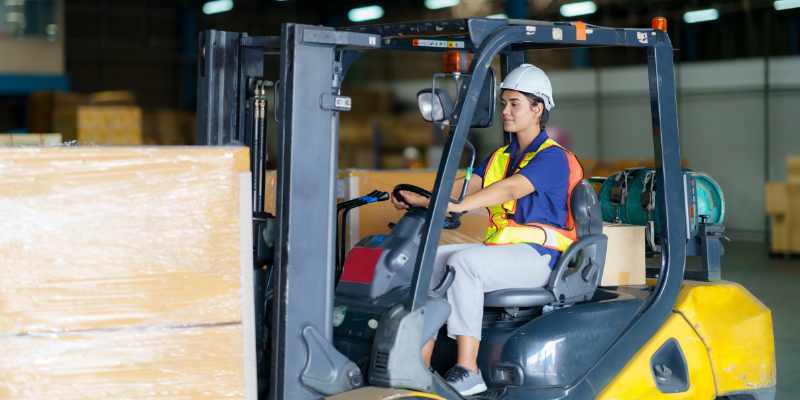MLITSD material handling inspections on now: Spotlight on young workers

For the third year, the Ministry of Labour, Immigration, Training and Skills Development (MLITSD) is conducting a focused inspection campaign on material handling at industrial workplaces. The campaign runs from April 1, 2025, to March 31, 2026, with inspectors visiting all types and sizes of manufacturing operations, including agriculture, automotive and food and beverage manufacturing.
“Material handling continues to be on the MLITSD’s radar because of the high number of injuries and fatalities associated with it,” explains Don Patten, WSPS Specialized Consultant (Ergonomics).
Material handling involves the movement of materials in and through a facility, performed either manually or by mechanical devices, such as mobile equipment, carts, or conveyors. Manual material handling can result in musculoskeletal disorders (MSDs), which are injuries affecting muscles, tendons, ligaments, and nerves. MSDs often stem from awkward postures and improper lifting techniques, says Don. Mechanical material handling can lead to injuries and fatalities when workers are crushed between objects or machines, or struck by objects, such as falling materials, swinging equipment or vehicles.
“These incidents are particularly dangerous and are the leading cause of fatalities in material handling environments,” notes Don. According to WSIB provincial statistics, in 2024, there were a total of 27 fatalities, including eight crushed by and six struck by. Sadly, two of these fatalities involved young workers.
For this reason, MLITSD inspectors will pay special attention to workplaces where new and young workers or temporary help agency workers are present. “These workers are more susceptible to material handling injuries because they often lack experience and may not receive the continuous training provided to seasoned employees,” explains Don. “They may not fully understand or recognize workplace hazards or feel comfortable asking for help. Temporary workers also may not speak English as their first language or be familiar with the specific safety protocols of their temporary assignments.”
What inspectors will look for
“While this campaign covers all material handling tasks, inspectors will be paying particular attention to jobs like cleaning around moving equipment, repairing or adjusting machinery, lift truck operations around storage systems, pedestrian traffic around moving equipment and machinery, as well as manual handling of materials," says Don.
In addition to a physical inspection of the workplace, inspectors will do an administrative review. “This would include assessing the effectiveness of training and communication,” says Don. “In particular, they will want to see evidence that young, new and temporary workers have received training on hazard recognition and safe work practices and that they understood the content,” says Don.
“For vulnerable workers, frequent training is essential, ensuring that instructions are clear and easily understood,” explains Don. “Implementing supervision and mentoring programs can help them navigate their tasks safely, with experienced workers guiding them through safety protocols.”
How to prepare for an inspection
To prepare for an inspection from the MLITSD, ensure you have identified all hazards and mitigated or eliminated them. “It’s a good idea to complete a risk assessment,” says Don. “It will help identify the hazards associated with moving your materials. Understanding these hazards will help you determine the safest way to get the job done and allow you to develop and implement the appropriate hazard control programs.”
Make sure the following documents are up to date and available for the inspector to review:
- JHSC meeting minutes
- previous inspection reports
- health and safety policies and procedures
- first-aid records
- training records
- ergonomics or hygiene test results
- incident reports
The inspector will also check whether you have all the required health and safety documents posted on your health and safety board. A virtual option is permitted, provided that the employer guides workers on how to locate and access the information electronically.
How WSPS can help
Free workplace assessment
WSPS offers a free workplace assessment to help you improve processes, reduce risks, and protect your people. From manual handling to automation and storage systems, our experts provide practical recommendations and tools to keep your operations in motion. Learn more and book your free assessment.
Guides to prepare for inspections
- Manual Material Handling
- Storage Systems
- Lifting Devices, Mobile Equipment or Cranes
- Workplace Layout and Design
- Automation
Free resources and support
- Safety Connection: MLITSD Material Handling Campaign 2025-2026 (pre-recorded webinar)
- Preparing for a Ministry of Labour, Immigration, Training and Skills Development Inspection
- What to expect when a Ministry inspector comes to your workplace (article)
- Material Handling resources for workers, supervisors and employers - Worker resources available in six languages.
- Business in Motion: Managing Material Hazards (free tool)
- Lighting Risk Identification (guide)
- Proper Lighting in Industrial Work Environments (guide)
Training
- Online Instructor-led Training Courses (ergonomics, musculoskeletal disorders, machine & robot safety, warehouse safety & racking)
The information in this article is accurate as of its publication date.




